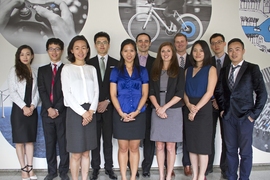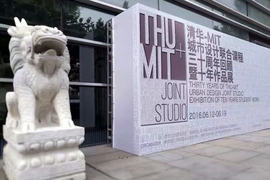In China, city development through effective planning and real estate investment is serious business, but learning about it can be fun and games. Thanks to a new approach developed at MIT, a game based on socially responsible real estate practices was tested in China this summer.
The Samuel Tak Lee MIT Real Estate Entrepreneurship Lab (STL Lab) and the MIT Game Lab collaborated to develop a game designed to help young people understand socially responsible real estate practices and the consequences of irresponsible development, in a safe, fast-paced game environment and without the potential adverse effects of experimenting in the real world. Aimed at students between 16 and 22 years old, the game demonstrates that the best strategy for maximizing long-term profit from real estate investment is to invest adequately in the public good.
Reflecting the mission of the STL Lab, the game has been in development since September 2015, primarily as a way to reach Chinese high school and college students. Eran Ben-Joseph, professor and head of the Department of Urban Studies and Planning (DUSP), first suggested that games could be a good way to engage these audiences.
In discussing game-based learning with STL Lab staff, MIT Game Lab studio manager Richard Eberhardt says, “Education is learning that happens during the institutional process, often with no option not to do it, while play often is the more motivated way of learning that happens every day. Games are a safe way to activate play in a fun and challenging environment.”
According to Sara Verrilli, development director of the MIT Game Lab, “games give players opportunities to fail,” which is something often avoided — and costly — in traditional school settings. Supporting and normalizing failure results in rich learning and teaching opportunities for both game players and game developers. Specifically, this game enables players to create novel models of socially responsible real estate entrepreneurship, with some investment decisions reaping greater short- and long-term rewards than others.
The game is played in rounds by four players. Each player accumulates cash, which can be used to develop real estate projects such as historic sites, schools, apartment complexes, factories, and shopping centers. Players also accumulate prestige, based on socially conscious real estate investments, that partly determines the game’s winner. Cash is generated from built projects or taking on debts, while prestige can be gained only by investing in projects that have social benefits, such as culturally significant buildings and community services.
Projects come to players in several categories and are built on a constrained orthogonal grid map. The game emphasizes spillover effects, or urban externalities. For example, building a cultural site beside a residential site improves value for both development sites and, by extension, the developers. Conversely, building a cultural site beside a factory reduces the value of the culturally significant building.
The game also supports other modes of play, such as two-player teams and cooperative modes, to foster a more collaborative experience. “We found that more Chinese students enjoyed a collaborative way of playing,” Eberhardt says. “Even in competitive games, they were happy to give each other advice.”
Members of the MIT Game Lab developed various models, and the STL Lab provided insight on the translation of urban planning and real estate issues into rule-based languages. The STL Lab also organized test play sessions with faculty and students from DUSP, and Professor David Geltner from the Center for Real Estate provided guidance regarding real estate financing. The current beta version is the result of dozens of reviews, critiques, and rounds of internal testing. Yu-Hung Hong, director of the STL Lab, found the collaboration with the MIT Game Lab a satisfying experience. “The Game Lab was very professional and listened closely to our suggestions,” he says.
This year, the MIT Game Lab made two trips to China, visiting Inner Mongolia University of Technology (IMUT), Tsinghua University (THU), Tongji Zhejiang College, Qingdao University of Science and Technology, and Xiamen University. These trips allowed game developers to gain a better understanding of Chinese social contexts, informing subsequent refinements to the game.
Eberhardt says that the team was able to gather a lot of valuable data during these trips, and the feedback from Chinese students was generally positive. “Different combinations of projects produced innumerable situations,” one stated. “The game was very exciting.” A student from Tsinghua University wrote, “I managed to change my strategy and role from profit-seeking to socially responsible the second time I played it. … It also encouraged me to think about what society would be like if we had a full-fledged financial system in the real world.”
“Students also provided creative insight on the game,” Eberhardt says. “For example, one student pointed out that the land value in the game’s city center does not appreciate as it usually does in reality.” Land in city centers is typically valued more than surrounding real estate, while the current iteration of the game distributes value across all land parcels equally. The MIT Game Lab will work on incorporating this important student feedback into the game to ensure that it is as realistic as possible.
The game was a core component of STL-MISTI China Summer Camp, jointly developed by the STL lab and the MIT International Science and Technology Initiatives (MISTI). The program brought together MIT graduate and undergraduate students and students from six Chinese universities to learn about real estate development and entrepreneurship through the lens of social responsibility in a collaborative global context.
The end of the STL-MISTI China Summer Camp brought about a new stage of game development. Hong said that there is still much to be done, as the current version requires further artistic polishing and marketing. The STL Lab and the MIT Game Lab expect to test the complete prototype in 2017.












